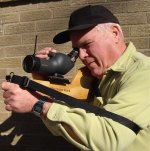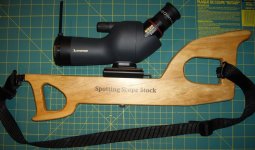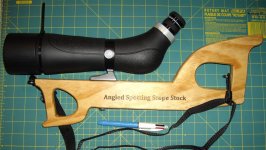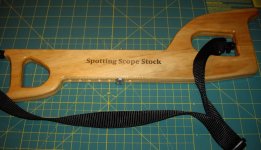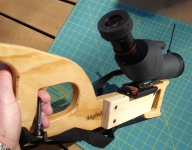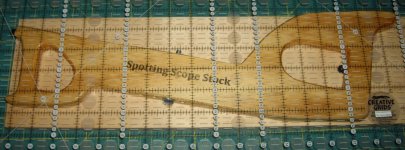For relatively low power (12-24x), wide field scope viewing, a simple shoulder stock holding a small spotting scope can be a good option. It is easy to carry, handy to use, much faster to point at a bird than a tripod mounted scope, and steadier than handheld high magnification binoculars. The view is especially solid if a nylon or leather sling attached to the front and back of the stock is looped over the middle of the upper left arm (for right-handed users), with the stock butt against the right shoulder and left hand on the front grip. In this position, the stock can be held steady in a tension triangle with the sling while focusing is done with the right hand. See Photo 1. While it helps to have had experience similarly bracing a rifle with sling in “position” target shooting, it is not very difficult for a complete beginner to learn to hold the shoulder stock mounted spotter very steady using a sling. Conventional wisdom says that a spotting scope on a shoulder stock is easy to aim only if a straight-through viewing spotting scope is used. See Photo 2 for a compact wooden shoulder stock for straight-through scopes. A straight-through Nikon ED50 is mounted.
Recent work with angled scopes mounted on a different design home made wooden stock shows that “conventional wisdom” about this is only partially correct. While both red-dot and repurposed Nydar reflex sight units make for easy sighting on larger tripod-mounted angled scopes, the problem of aiming a small stock-mounted angled spotter is nicely solved by using the simple light weight “cable tie” method that has been described elsewhere on Birdforum. (See http://www.birdforum.net/showthread.php?t=166747&highlight=kabsetz+cable+tie+aim)
The general idea is to loop a releasable plastic cable tie around the objective end of the scope and snug it up, allowing the tag end to project upwards like a super-high front sight on a rifle. To make the initial adjustment to align the cable tie front sight, the scope is temporarily tripod mounted and pointed at a distinctive distant point so that aiming point is in the center of the field. The viewer then looks along the top of the scope, JUST over the top of the eyepiece from behind it, and rotates the cable tie loop until the vertically projecting end aligns with the aiming point, aligning azimuth. For elevation alignment, place a piece of masking tape or similar to mark the point on the vertically projecting cable tie that aligns with the elevation of the aiming point. Once marked, it is a simple task to use shears or scissors to cut off the extra vertical pointing cable tie at that point. Now if the scope is taken from the tripod and attached to the shoulder stock that holds the scope at a comfortable angle, it is simple to aim and then view by moving your head and eye very slightly from the “cable-tie aiming” position to the “45˚ eyepiece viewing” position. With just a little practice, this transition becomes as accurate and effortless as when the scope is tripod mounted.
I spent some time making various cardboard cutout models before coming up with a prototype shoulder stock that works well with 45˚ angled spotters. The key points are that the scope must be mounted at a comfortable viewing angle on the stock (you have to “look down” slightly) AND the stock profile must dip down to allow attaching the scope low enough that the line of sight from eyepiece top to cable-tie end aligns with the viewer’s eye. The idea is to make the stock so that when you place it to your shoulder and put cheek against the stock, your eye is aligned for viewing. The stock was made from an 18.5 inch long pine board 5.5 inches wide and ¾ inch thick. This is called a “1 by 6” by lumber suppliers. I cut out the stock outline with a power jig saw, but a sabre saw or even hand coping saw could be used. The sharp corners were rounded with a router, but this could have been done by hand with a wood rasp and sandpaper. My stock was finished with several coats of spar varnish, though you may opt to paint yours a camouflage tint or other color or just leave it bare wood. I avoid brown or black and keep the stock short so if other folks are near where I’m pointing it they can more easily discern that I’m NOT aiming a rifle in their direction. The stock looks a bit unconventional, but provides great utility and convenience for using small angled spotters. See Photo 3 for a view of the stock with a Nikon ED50a. Photo 4 shows a 60 mm Bresser Spektar (effective aperture 44 mm- from the $39.95 Explore Scientific “deal” back in 2015) mounted on another angled stock. Finally, Photo 5 shows a side view of just the wooden stock for angled scope.
[Because the Porro and half penta prism erecting system on the ED50a moves the eyepiece central axis about 15 mm to the left of the objective optical axis, the ED50a is ideal for right handed shoulder stock users. Setting up the stock for left-hand use (stock butt on left shoulder and sling over right arm) is a bit harder, since the eyepiece is then offset in the wrong direction, away from the left eye. You can correct this, however, by adding a wood block on the right side of the stock with a parallel line of attachment holes to shift the scope and eyepiece to the right for viewing with the left eye. A stock with this adaptation is shown in the next post.]
The sling is really necessary for viewing stability. For the most economical approach, the strap from the Nikon “holster” case that comes with new ED50’s can be repurposed as a shoulder stock sling. It has adjustable length and plastic clips already attached to the ends that can snap into eye screws secured in the stock (See Photo 4). You can get such eye screws at a local hardware store. A sling can also be made using colorful 1 inch nylon webbing (as used by rock climbers and available by the foot at outdoors stores or online) with plastic buckles and/or sewing to hold end loops. DO NOT trust a sling with plastic snap clip attachments to hold the stock with mounted scope slung over the shoulder when walking. I tested this by holding the sling and “bouncing” the suspended stock, without scope. In repeated trials, one clip usually detached from the eye screw in less than half a minute of this testing! It is fine during use, though, when the wooden stock is also held firmly in hand. For those not adverse to using rifle accessories for this non-firearm application, a commercial 1 inch adjustable nylon rifle strap provides a much better attachment. The strap and attachment hardware are low cost, and are very convenient and secure when steel quick detachable (QD) swivels fasten the strap to special (supplied) wood screws driven into the wooden stock. This provides such a robust attachment that you can confidently carry the stock and scope hanging from the sling over your shoulder while hiking. Such a sling and swivels are attached to the stock with the Nikon ED50a shown in the photos. “Uncle Mike’s” is a popular, well-made brand available in the USA. I bought a complete set of two 1” QD swivels with QD head attaching wood screws (Uncle Mike’s No. 3011) for $8.98 US and a 1” black nylon adjustable utility strap for $6.89 US (both including shipping) on ebay.
The spotting scope can be secured to the stock with a ¼-20 machine screw, cut to proper length to engage the scope’s tripod socket and pushed through a ¼ inch hole drilled completely through the stock from the top. My stock has 7 holes drilled 5/8 inch apart to allow scopes of different length to be attached and the stock height at the attachment holes is such that a 2 ½ inch long bolt can be used without shortening. I made a knurled head for the straight stock screw for hand tightening, but that is just for convenience as a 2 ½ inch hex or slotted head machine screw (see photos 3,4,5) works well. If you put two blades in a hacksaw frame at once, you can cut a slot across your ¼-20 hex bolt head wide enough to allow convenient tightening using a coin (US quarter or similar) in the slot. A flat washer between bolt head and stock makes it easier tighten firmly. Another useful addition is to mount a quick release receiver on the stock and a matching plate on the scope bottom for easy attaching and detaching the scope to the stock. The Stroboframe 300 Quick Release receiver and plate that allows attaching the scope with just one hand and “clicks” securely in place is especially nice. A bonus advantage here is the screw that attaches the Stroboframe plate to the ED50 bottom rides in a slot that allows 18mm of lateral scope adjustment to “fine tune” alignment of the eyepiece with your eye. If another Stroboframe quick release receiver is attached to your tripod head, this arrangement lets you remove the scope from the shoulder stock and rapidly “click” it onto the tripod head to provide rock-solid viewing with higher powers. The quick tripod mount makes it easy to share views with others, too.
The homemade shoulder stock is very nice to use for birding or viewing wildlife when holding the little Nikon ED50a scope with either the Nikon 16x WDS eyepiece with 4.5˚ field or (usually) an adapted low cost 20 mm SWA eyepiece giving 14x and an amazing 5˚ field. It also works well with the heavier Pentax PF65EDAII scope mounting a 26mm adapted 2” barrel diameter SWA eyepiece providing 15x and a 4.7˚ field or the Bresser Spektar 60mm with adapted 20mm SWA eyepiece providing 16x and a 4.4˚ field. The sling-braced stock should also be adequate for holding other brands of small angled spotters and can be used with zoom eyepieces or shorter FL eyepieces up to about 24x. It is harder to hold steady for extended viewing sessions with powers beyond that unless braced against a post, tree or other steadyment. The stock shown will not hold an 80mm scope comfortably and a bigger stock made to hold a larger scope would likely lack the “handy” and “easy to use” benefits of the one described.
I enjoy the closer views of birds and wildlife afforded by small angled scopes on the homemade stock and hope this information might motivate you to try building one for yourself. Making such a stock from a pine board is a nice DIY project. – Bill
Photo 1 Nikon ED50a w/stock & sling held for viewing
Photo 2 Nikon ED50 & 20mm SWA Eyp. w/ straight stock
Photo 3 Nikon ED50a & 20mm SWA Eyp. w/angled stock & QR sling
Photo 4 Angled Bresser Spektar & adapted 20mm SWA Eyp. w/stock & Nikon ED50 case sling snapped to eye screws
Photo 5 Angled wooden stock without scope
Recent work with angled scopes mounted on a different design home made wooden stock shows that “conventional wisdom” about this is only partially correct. While both red-dot and repurposed Nydar reflex sight units make for easy sighting on larger tripod-mounted angled scopes, the problem of aiming a small stock-mounted angled spotter is nicely solved by using the simple light weight “cable tie” method that has been described elsewhere on Birdforum. (See http://www.birdforum.net/showthread.php?t=166747&highlight=kabsetz+cable+tie+aim)
The general idea is to loop a releasable plastic cable tie around the objective end of the scope and snug it up, allowing the tag end to project upwards like a super-high front sight on a rifle. To make the initial adjustment to align the cable tie front sight, the scope is temporarily tripod mounted and pointed at a distinctive distant point so that aiming point is in the center of the field. The viewer then looks along the top of the scope, JUST over the top of the eyepiece from behind it, and rotates the cable tie loop until the vertically projecting end aligns with the aiming point, aligning azimuth. For elevation alignment, place a piece of masking tape or similar to mark the point on the vertically projecting cable tie that aligns with the elevation of the aiming point. Once marked, it is a simple task to use shears or scissors to cut off the extra vertical pointing cable tie at that point. Now if the scope is taken from the tripod and attached to the shoulder stock that holds the scope at a comfortable angle, it is simple to aim and then view by moving your head and eye very slightly from the “cable-tie aiming” position to the “45˚ eyepiece viewing” position. With just a little practice, this transition becomes as accurate and effortless as when the scope is tripod mounted.
I spent some time making various cardboard cutout models before coming up with a prototype shoulder stock that works well with 45˚ angled spotters. The key points are that the scope must be mounted at a comfortable viewing angle on the stock (you have to “look down” slightly) AND the stock profile must dip down to allow attaching the scope low enough that the line of sight from eyepiece top to cable-tie end aligns with the viewer’s eye. The idea is to make the stock so that when you place it to your shoulder and put cheek against the stock, your eye is aligned for viewing. The stock was made from an 18.5 inch long pine board 5.5 inches wide and ¾ inch thick. This is called a “1 by 6” by lumber suppliers. I cut out the stock outline with a power jig saw, but a sabre saw or even hand coping saw could be used. The sharp corners were rounded with a router, but this could have been done by hand with a wood rasp and sandpaper. My stock was finished with several coats of spar varnish, though you may opt to paint yours a camouflage tint or other color or just leave it bare wood. I avoid brown or black and keep the stock short so if other folks are near where I’m pointing it they can more easily discern that I’m NOT aiming a rifle in their direction. The stock looks a bit unconventional, but provides great utility and convenience for using small angled spotters. See Photo 3 for a view of the stock with a Nikon ED50a. Photo 4 shows a 60 mm Bresser Spektar (effective aperture 44 mm- from the $39.95 Explore Scientific “deal” back in 2015) mounted on another angled stock. Finally, Photo 5 shows a side view of just the wooden stock for angled scope.
[Because the Porro and half penta prism erecting system on the ED50a moves the eyepiece central axis about 15 mm to the left of the objective optical axis, the ED50a is ideal for right handed shoulder stock users. Setting up the stock for left-hand use (stock butt on left shoulder and sling over right arm) is a bit harder, since the eyepiece is then offset in the wrong direction, away from the left eye. You can correct this, however, by adding a wood block on the right side of the stock with a parallel line of attachment holes to shift the scope and eyepiece to the right for viewing with the left eye. A stock with this adaptation is shown in the next post.]
The sling is really necessary for viewing stability. For the most economical approach, the strap from the Nikon “holster” case that comes with new ED50’s can be repurposed as a shoulder stock sling. It has adjustable length and plastic clips already attached to the ends that can snap into eye screws secured in the stock (See Photo 4). You can get such eye screws at a local hardware store. A sling can also be made using colorful 1 inch nylon webbing (as used by rock climbers and available by the foot at outdoors stores or online) with plastic buckles and/or sewing to hold end loops. DO NOT trust a sling with plastic snap clip attachments to hold the stock with mounted scope slung over the shoulder when walking. I tested this by holding the sling and “bouncing” the suspended stock, without scope. In repeated trials, one clip usually detached from the eye screw in less than half a minute of this testing! It is fine during use, though, when the wooden stock is also held firmly in hand. For those not adverse to using rifle accessories for this non-firearm application, a commercial 1 inch adjustable nylon rifle strap provides a much better attachment. The strap and attachment hardware are low cost, and are very convenient and secure when steel quick detachable (QD) swivels fasten the strap to special (supplied) wood screws driven into the wooden stock. This provides such a robust attachment that you can confidently carry the stock and scope hanging from the sling over your shoulder while hiking. Such a sling and swivels are attached to the stock with the Nikon ED50a shown in the photos. “Uncle Mike’s” is a popular, well-made brand available in the USA. I bought a complete set of two 1” QD swivels with QD head attaching wood screws (Uncle Mike’s No. 3011) for $8.98 US and a 1” black nylon adjustable utility strap for $6.89 US (both including shipping) on ebay.
The spotting scope can be secured to the stock with a ¼-20 machine screw, cut to proper length to engage the scope’s tripod socket and pushed through a ¼ inch hole drilled completely through the stock from the top. My stock has 7 holes drilled 5/8 inch apart to allow scopes of different length to be attached and the stock height at the attachment holes is such that a 2 ½ inch long bolt can be used without shortening. I made a knurled head for the straight stock screw for hand tightening, but that is just for convenience as a 2 ½ inch hex or slotted head machine screw (see photos 3,4,5) works well. If you put two blades in a hacksaw frame at once, you can cut a slot across your ¼-20 hex bolt head wide enough to allow convenient tightening using a coin (US quarter or similar) in the slot. A flat washer between bolt head and stock makes it easier tighten firmly. Another useful addition is to mount a quick release receiver on the stock and a matching plate on the scope bottom for easy attaching and detaching the scope to the stock. The Stroboframe 300 Quick Release receiver and plate that allows attaching the scope with just one hand and “clicks” securely in place is especially nice. A bonus advantage here is the screw that attaches the Stroboframe plate to the ED50 bottom rides in a slot that allows 18mm of lateral scope adjustment to “fine tune” alignment of the eyepiece with your eye. If another Stroboframe quick release receiver is attached to your tripod head, this arrangement lets you remove the scope from the shoulder stock and rapidly “click” it onto the tripod head to provide rock-solid viewing with higher powers. The quick tripod mount makes it easy to share views with others, too.
The homemade shoulder stock is very nice to use for birding or viewing wildlife when holding the little Nikon ED50a scope with either the Nikon 16x WDS eyepiece with 4.5˚ field or (usually) an adapted low cost 20 mm SWA eyepiece giving 14x and an amazing 5˚ field. It also works well with the heavier Pentax PF65EDAII scope mounting a 26mm adapted 2” barrel diameter SWA eyepiece providing 15x and a 4.7˚ field or the Bresser Spektar 60mm with adapted 20mm SWA eyepiece providing 16x and a 4.4˚ field. The sling-braced stock should also be adequate for holding other brands of small angled spotters and can be used with zoom eyepieces or shorter FL eyepieces up to about 24x. It is harder to hold steady for extended viewing sessions with powers beyond that unless braced against a post, tree or other steadyment. The stock shown will not hold an 80mm scope comfortably and a bigger stock made to hold a larger scope would likely lack the “handy” and “easy to use” benefits of the one described.
I enjoy the closer views of birds and wildlife afforded by small angled scopes on the homemade stock and hope this information might motivate you to try building one for yourself. Making such a stock from a pine board is a nice DIY project. – Bill
Photo 1 Nikon ED50a w/stock & sling held for viewing
Photo 2 Nikon ED50 & 20mm SWA Eyp. w/ straight stock
Photo 3 Nikon ED50a & 20mm SWA Eyp. w/angled stock & QR sling
Photo 4 Angled Bresser Spektar & adapted 20mm SWA Eyp. w/stock & Nikon ED50 case sling snapped to eye screws
Photo 5 Angled wooden stock without scope




